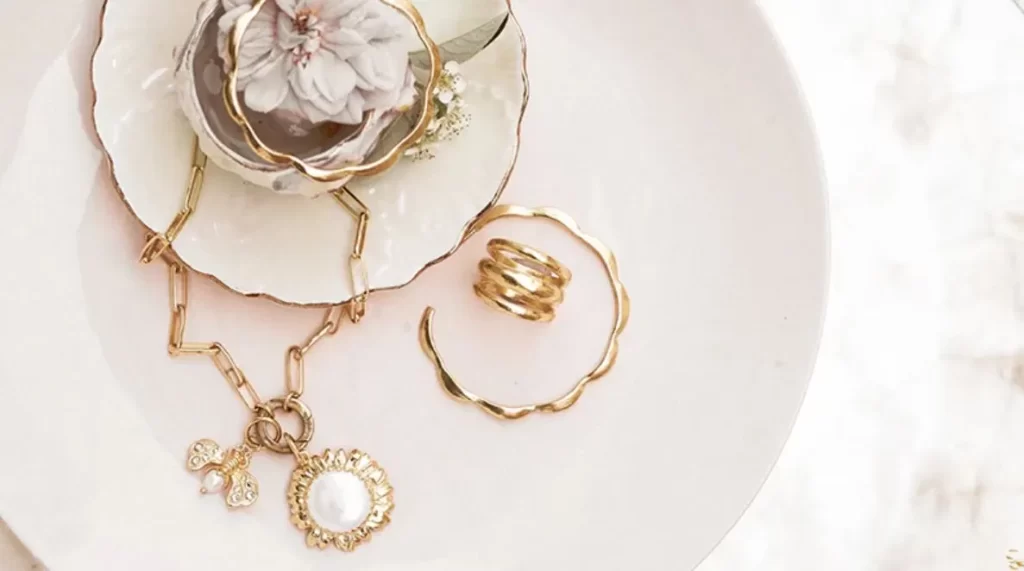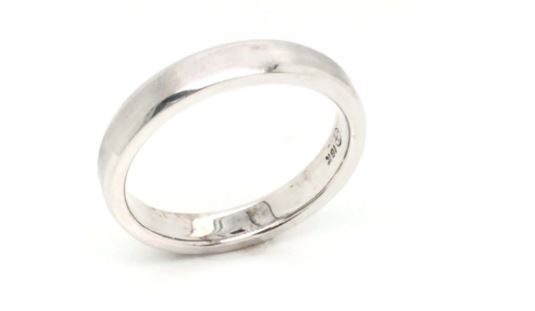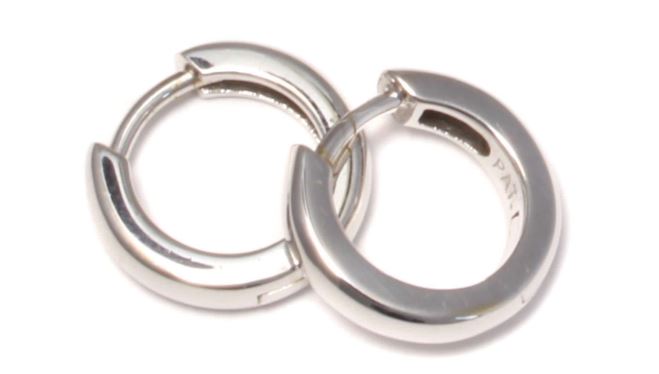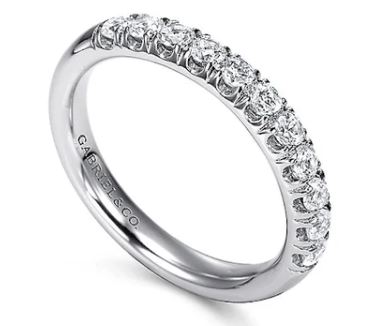Palladium White Gold vs Traditional White Gold
White gold is an alloy of gold with other metals to give it a silvery, white appearance. Pure gold, which is yellow, is mixed with white metals such as palladium, nickel, or silver to achieve this look. The resulting alloy is then often coated with rhodium to enhance its whiteness and shine.
This guide will explore differences between palladium white gold and traditional white gold in detail, so you can make an informed choice that best suits your needs and preferences.
What is Palladium White Gold
Palladium white gold is an alloy made by combining gold with palladium, a member of the platinum group of metals. The primary purpose of adding palladium to gold is to achieve a white color while enhancing the metal’s durability and hypoallergenic properties.
Composition and Properties of Palladium White Gold
Gold: The main component, usually in 14k (58.5% gold) or 18k (75% gold) purity.
Palladium: Added to the gold to provide a white color and increase strength. The percentage of palladium can vary but is typically between 10-25%.
Other Metals: Small amounts of other metals like silver or copper may be included to fine-tune the alloy’s properties.
Palladium white gold is chosen for its aesthetic appeal, durability, and hypoallergenic properties. It’s a preferred option for those who want the look of platinum without the weight or cost, and for anyone with sensitivities to nickel or other common metals used in jewelry alloys.

Benefits of Palladium White Gold
1. Natural White
Palladium white gold maintains a true white color without needing additional plating. This can save you the money of plating.
2. Durability
It’s less prone to atmospheric reactions like tarnishing compared to nickel white gold. So one can expect less maintenance problems.
3. Hypoallergenic
Suitable for individuals with sensitive skin or nickel allergies. This can be counted as one of the biggest makes it different from nickel white gold other than cost.
Drawbacks of Palladium White Gold
1. Cost
Palladium is generally more expensive than nickel, which can make palladium white gold jewelry pricier.
2. Scratching
Palladium is one of those metals where any scratching leads to displacing of the metal rather than wearing it off. This results in a lot of scratches which will ultimately effect overall appearance of your jewelry.

Uses of Palladium White gold
Engagement Rings and Wedding Bands: Its durability, natural white color, and hypoallergenic properties make it an ideal choice for rings that are worn daily.
Fine Jewelry: Palladium white gold is used in earrings, necklaces, bracelets, and other luxury jewelry items due to its lustrous appearance and resistance to tarnish.
Luxury Watches: High-end watchmakers use palladium white gold for cases, bands, and sometimes internal components, leveraging its strength and aesthetic appeal.
What is Traditional White Gold
Traditional white gold or nickel white gold is an alloy created by combining pure gold with nickel and sometimes other metals such as copper, zinc, and palladium. This mixture gives the gold a white appearance, making it a popular choice for jewelry.
Composition and Properties
Nickel White Gold typically consists of the following elements:
Gold: The primary component, usually ranging from 58.3% (14K) to 75% (18K) of the alloy.
Nickel: Added to give the gold its white color and to increase its strength and durability.
Other Metals: Small amounts of other metals like copper, zinc, and palladium may also be included to enhance specific properties such as malleability and color stability.
The exact proportions of these elements can vary depending on the desired properties and the specific formulation used by the jeweler. Nickel White Gold has a bright white appearance, which is often enhanced by rhodium plating. Rhodium is a precious metal in the platinum family that is applied as a thin coating over the white gold to give it a brilliant, reflective finish and to protect the inside metal from tarnish and scratches.
Benefits of Nickel White Gold
1. Cost-Effective
Nickel is less expensive than other white metals like palladium and platinum, making Nickel White Gold a more affordable option for white gold jewelry.
2. Durability
The addition of nickel makes the alloy strong and hard, suitable for everyday wear. Any incidents of scratching or dinging will not cause any kind of damage to your jewelry. This durability is particularly beneficial for items like rings and bracelets that are subjected to frequent handling and contact.
3. Versatility
Nickel White Gold can be used in various types of jewelry, from engagement rings and wedding bands to necklaces, earrings, and bracelets.

Drawbacks of Nickel White Gold
1. Allergies
One of the main drawbacks of Nickel White Gold is its potential to cause allergic reactions. Nickel is a common allergen, and prolonged contact with the skin can lead to irritation and dermatitis in some individuals. This is a significant consideration for those with sensitive skin or known nickel allergies.
2. Rhodium Plating Maintenance
While rhodium plating gives Nickel White Gold its bright white finish, it can wear off over time, especially with frequent wear. This means the jewelry will need periodic re-plating to maintain its appearance. Without the rhodium coating, the underlying nickel alloy may develop a yellowish tint.
Uses of Nickel White Gold
Nickel White Gold is used in a wide range of jewelry, including:
Engagement Rings: The strength and affordability of Nickel White Gold make it a popular choice for engagement rings. Its bright white appearance complements diamonds and other gemstones beautifully.
Earrings and Necklaces: Less prone to wear than rings, earrings, and necklaces made from Nickel White Gold can retain their appearance longer between rhodium replating.
Bracelets and Bangles: These items benefit from the alloy’s strength, ensuring they withstand daily use and potential impacts.
Choosing Between Palladium White Gold and Nickel White Gold
When deciding between palladium white gold and nickel white gold, consider the following factors:
Budget
Palladium white gold tends to be more expensive due to the higher cost of palladium. If budget is a major concern, nickel white gold offers a more affordable alternative in the line up of white gold. However, remember to cater in the potential additional cost of rhodium plating for nickel white gold if you want to go for it.
Skin Sensitivity
If you have sensitive skin or are allergic to nickel, palladium white gold is the better choice. Palladium is hypoallergenic and less likely to cause skin reactions. Basically wherever nickel is involved in higher percentages, it is going to cause skin problems to people with sensitive skins.
Durability and Maintenance
Both metals are durable, but nickel white gold generally offers better scratch resistance against scuffs and dinging. And if you go with rhodium plating with nickel white gold, then case will be totally different as you will have to do additional care for your plating as well.
Platinum white gold on the other hand can be a bid more prone to scratching and stuff like it. But most importantly it does not require additional rhodium plating. So if you save your jewelry from potential scratches, maintenance can be far less as this leaves you with a pure alloy with no kind of additional care to be taken of plating.

Aesthetic Preferences
Consider the appearance you desire. Palladium white gold has a naturally bright white finish and maintains its color without rhodium plating. Nickel white gold often needs rhodium plating to achieve a similar level of whiteness. Your choice might depend on whether you prefer the natural hue of palladium or the potentially warmer tone of nickel.
Long-Term Considerations
Think about the long-term implications of your choice. Palladium white gold will retain its appearance and hypoallergenic properties over time with minimal maintenance. Nickel white gold might require periodic rhodium replating to maintain its look, and there’s the potential for allergic reactions.
Conclusion
Choosing between palladium white gold and nickel white gold ultimately depends on your personal preferences, budget, and specific needs. Palladium white gold offers a hypoallergenic, durable option with a naturally white hue, though it comes at a higher cost. Nickel white gold, while more affordable, may require additional maintenance and isn’t suitable for those with nickel allergies.